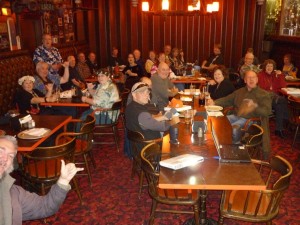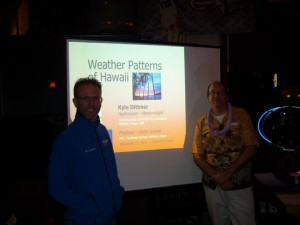Oregon Chapter – American Meteorological Society
A group welcoming weather professionals, enthusiasts, and those with an interest in science.
Meeting Notes: Weather Patterns of Hawaii
Why Study It?
1. The connection between Hawaii and PNW Weather 2. Understand climate variability (i.e., ENSO) 3. Good
to know for travel to Hawaii.
Kyle interviewed Dr. Gary Barnes of the U-Hawaii (Manoa), Chairman of the Dept. Atmospheric Science. Kyle gave a climate change seminar for the students beforehand.
What Are The Patterns?
1. Repeatable…but is it the same everywhere? The daily forecast temperatures are usually within 5 degF of each island, but the variability across any island can be large. How does terrain affect the weather? Hawaiian geography is similar to that of Oregon – many valleys, hills, and mountains.
2. Rainfall Gradients…intense but it varies locally. Honolulu can be dry (1-20 inches per year) but in the nearby Koolau Range can be over 200 inches per year. What about other Islands? We see a similar pattern…trending higher on the NE coast lines vs SW facing coastlines. Kauai has the highest rainfall at over 400 inches a year. Hawaii has full range of climates. Why do we see the pattern?
3. Prevailing Wind….Trade Winds. The Trade Winds deliver Hawaii’s only freshwater via rainfall. Natural water is stored in the volcanic rocks.
3. Trade Wind Inversion – temps warm with increasing heights, as local inversions, which helps to cause the frequent afternoon rain storms.
– Hurricanes. Hurricane Iniki (1992) changed course abruptly and mowed over Kauai with widespread wind and tidal storm surge damage. If Hawaii were further south and west, then many more hurricanes would blow over. On his last two days in Honolulu, Kyle experienced Hurricane Ana, with very intense rains. Winds were only 15-25 mpg, G 35-40.
– Flash Floods. Due to its tropical location, intense rains can strike Hawaii almost any time of the year (but autumn-winter being the most likely) and may create a flash flood. He learned that one of the most intense rainfall rate was 28-inches in 4-hours. Flash floods, and not hurricanes, are the most dangerous and frequent weather hazard in Hawaii.
Kauai Audio-Video Montage
Pineapple Express
What is it? P-Express is an Atmospheric River that connect tropical airflow to high latitude land
Development? (1) Air flow lift of moisture plume occurs off the ocean surface. (2) Large dew-point depression beneath cloud base. At 600 mb dry air sinks and forms a disconnect between Ocean and P-Express. A P-Express can’t exist entirely at 200-300 mb.
How much rain does it deliver? Two driving factors: (1) How much time in residence (hover around Hawaii)? (2) How much is lost in transit?
New Research areas: (1) What’s the relationship between P-Express and natural climate variability and climate change? (2) What’s the relationship between ENSO and P-Express?
More Questions to consider: (1) What P-Express impacts have occurred and can be re-analyzed? Need to re-examine past extreme West Coast precipitation events to see if there is a P-Express connection. Dettinger (2011) paper did this for California (http://tenaya.ucsd.edu/~dettinge/md_jawra2011.pdf). (2) Does the P-Express occur in other areas of the Earth? Yes, one hit England in 2009. (3) What are the impacts of P-Express on PNW Salmon? It depends on each stream. Some high flow can clean out fine debris in the gravels, helping the salmon eggs, but too much high flow can scour and destroy the salmon eggs. This blowout already occurred in a north Washington Cascades stream in the last 10 years.
Big Island Audio-Video Montage
We ended with a good Q&A session, enjoyed our good food and drink at the Stark Street Pizza House. Attendance was 41.



